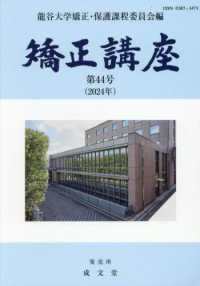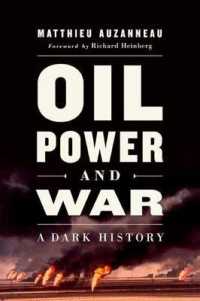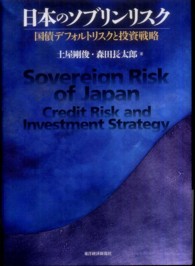- ホーム
- > 洋書
- > 英文書
- > Cinema / Film
Full Description
Spectacle, myth, fable - these words instantly leap to mind when considering director Sergio Leone's celebrated films. His popularization of the Spaghetti Western genre, through works like A Fistful of Dollars (1964) and Once Upon a Time in the West (1968), continues to have a profound impact on filmmakers worldwide. In this exciting new study, Italian film scholar Christian Uva explores a side of Leone's works rarely before discussed: the political. Grappling with the contradictions between Leone's politically critical cinematic eye and his aversion to ideological classification, Sergio Leone: Cinema as Political Fable makes sense of how the director's internal political tensions shaped the radical themes of his Western fables.
Looking at Leone and his films through a number of lenses, the book examines the elements of Italian history and identity interwoven in the director's stories, provides cultural context for a career spanning from Italy's fascist regime to Leone's death in 1989, and discusses the influences that formed Leone's directorial identity. Uva focuses in particular on the postmodernist theory behind Leone's works, revealing the critical basis of his stylistic and narrative innovations and newly analyzing the most iconic sequences from The Good, the Bad, and the Ugly (1967), Duck, You Sucker (1971), and Once Upon a Time in America (1984). An admirably thorough take on the man and his works, Sergio Leone: Cinema as Political Fable provides fresh perspective on a director long-established in cinema canon.
Contents
1. Sergio Leone's Short Century
1.1. A Childhood in the Shadow of the Regime
1.2. The Apprenticeship Years: Between National-Popular and Engaged Cinema
1.3. The Debut: From Myth to Historical Imagery
1.4. Leone's Road to Western
1.5. Engaged Cinema
1.6. From Director to Producer
1.7. From the 'Film of Films' to the Unfinished Project
2. Cinema Between Fable and Political Mythology
2.1. Political Spectacle
2.2. Postmodern as the 'Third Way'
2.3. World Metaphors and Thought Models Between Gramsci and Jünger
2.4. Repressing Fascism: Leone's Sword-and-Sandal Debut
2.5. The First Trilogy: Men With No Names and Subversive Dis-Identities
2.6. The Second Trilogy: Historical and Political Imagery in a Fable World
3. Three Sequences
3.1. Dislocations and Symbols Between Macrohistory and Microhistory
3.2. "Revolution Is an Act of Violence"
3.3. Voyeurism, Gender, Jewishness








